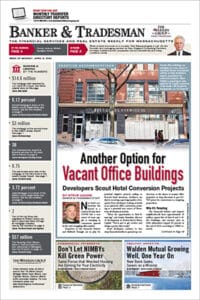
Tamara Small
Whether it’s in a board room, on a soccer field, or at the doctor’s office, the conversation invariably touches on traffic. Our daily commutes have become personal battles and the details are shared like war stories.
As area residents know, and as multiple reports have confirmed, congestion has gotten worse in Greater Boston. Boston’s economy is booming – with nearly 100,000 new jobs created in the last year alone. There are 300,000 more vehicles on the road than five years ago, which is only projected to grow with the on-demand economy. The result? Bottlenecks on highways and local roads throughout the region. It’s clear that creative solutions, big and small, are needed to address congestion.
Boston is not alone. Other cities across the nation are struggling to address traffic, air pollution, unsafe roads and emissions. Recognizing that the U.S. benefits by learning how other nations have tackled this issue the Bloomberg American Cities Climate Challenge, along with the Barr Foundation, brought a study group to London and Stockholm to see firsthand how these cities have used one specific tool: congestion pricing.
How Other Cities Tackle Traffic
The group, of which I was a part, included elected officials, environmental advocates, and business representatives from San Francisco, Seattle, Portland, Washington, D.C., Honolulu, Boston and Philadelphia. We met with government officials, transit industry experts, and local community members who shared how London and Stockholm implemented congestion pricing and how it has evolved over the years.
London launched congestion pricing in 2003 after Ken Livingstone’s mayoral campaign included a pledge to reduce the number of vehicles entering the city. In advance of the launch of the program, London focused on making public transit and other alternatives to car travel easier, cheaper, faster and more reliable. It expanded its already robust public transit options by adding 300 buses, froze fare increases, created discounts for residents in the district and upgraded trains and subways heading into the zone.
Within the first year of the program, the number of cars in the congestion pricing zone dropped, eventually creeping back up somewhat as the population increased and road capacity was reduced by allocating space to cyclists, pedestrians, and buses. Today, the number of people riding buses is up 40 percent and twice as many people commute by bicycle than in the year 2000. Overall, traffic in London has decreased by 20 percent.
In Stockholm, congestion pricing was implemented in 2007 after a six-month pilot program. Again, in preparation for the program, major investments in public transit were made, including 14 new bus lines, more high frequency trains, and 2,500 new park and ride spots. People experienced a decrease in traffic congestion starting on day one of the program, which has continued with a permanent reduction of 20 percent less traffic.
Four Key Takeaways
In some ways, comparing Boston to Stockholm or London is not an apples–to–apples comparison. These cities have very different public transit systems. However, as the Greater Boston area attempts to address congestion through a variety of mechanisms, the following are the key takeaways from the study trip:
- Pilot programs work. In Stockholm, public support for congestion pricing was extremely low until a pilot program allowed people to experience it firsthand. It demonstrated the significant impact congestion pricing could have on traffic. A pilot program also provides critical data that could shape and fine–tune a more comprehensive program.
- People will not get out of their cars if alternative mobility options do not exist. Whether it’s new protected bike lanes, expanded bus routes or increased frequency of commuter rail and subways, investments and expansion must be made before a comprehensive congestion pricing program can succeed. Importantly, the revenue generated by congestion pricing in Stockholm and London was used to further expand these options. In addition, riders must be confident that the public transit system is reliable.
- A successful congestion pricing program must consider equity – whether it is the impact on certain populations or regions. Outreach to key community stakeholders along with data collection on exactly who would be impacted and in what ways are critical in the development of congestion pricing programs.
- Congestion pricing is an effective tool. Cordon and area pricing have generally reduced driving by 15-20 percent and congestion by 30 percent or more. Importantly, in Stockholm, even after investments were made to expand public transit options, ridership did not increase until after congestion pricing was implemented. This is proof that a carrot and stick approach is needed to effectively reduce congestion.
One thing is clear, there is no one silver bullet that will reduce congestion throughout Greater Boston. A wide range of investments and actions is needed. MassDOT recently issued recommendations on how they plan to tackle congestion including, among other things, addressing local and regional bottlenecks where feasible; reinventing bus transit at both the MBTA and at regional transit authorities; increasing MBTA ridership and capacity; and creating infrastructure to support shared travel modes.
Changes of all sizes will make a difference and NAIOP looks forward to working with MassDOT and key stakeholders as discussions around addressing congestion continue.
Tamara Small is CEO of NAIOP-MA – The Commercial Real Estate Development Association.





